1975
There are only three people in these images: Rhoddy Macleod, proprietor and owner of Fascadale, Bobby Macleod, his wife and Paul Taylor, seasonal fisherman and then a student at Stirling University

© Don McAllester
Photo 200
Rhoddy Macleod and Paul Taylor dragging the boat down the beach
Most fishing days started by dragging one of the clinker-built dinghies down the “raised” stony beach into the sea so that the crew could row out to the salmon coble. The dinghy in the picture is the old “grey dinghy” slightly bigger than the old “blue dinghy” How old these boats were and where they were built is a mystery though it was said that the blue boat, smaller and with slightly finer lines may have been a Loch Shiel boat.
The coble remained on a mooring in the bay throughout the fishing season. She was too big a boat to be brought ashore and relaunched every day.
There were a pair of “Seagull” outboards at Fascadale but these were seldom used and never for the short trip out to the coble. The Fascadale dinghies had two rowing positions, one on the midships thwart (cross bench) and one on the forward thwart. The forward position was always used: it made it easier to carry fish boxes and other gear in the space in the stern of the boat. If you look carefully at the photograph you can see the rowlocks in the forward position
The dinghies were dragged down to the sea manually but were towed back up by LandRover. At the end of the day, and when the dinghy was down the beach a long wire rope was pulled down and tied onto the boat. The other end of the wire rope went onto an old LandRover up on the hard ground .As the vehicle reversed the boat was towed up the beach and above the high tide line. This treatment did the dinghies no good at all as can be seen in photo 242 “Carrying the Catch”
In the foreground of the photo is visible one of the two “swell lines” . These lines consisted of a hefty anchor at the seaward end attached to a wire rope that led up the beach to a lighter line that was used to tension the swell line to a strong point outside the boat shed. These two swell lines ran in parallel, about three metres apart all the way down the beach to their anchors in deeper waters. The swell lines were laid at the start of the season and lifted at the end. Their purpose was to facilitate holding a boat in place, either afloat or grounded at any stage of the tide. You can see them in use in the photos No 222 “Loading the boat” , Photo 242 below . The swell lines’ anchors were buoyed to make them easier to lift.
At the top of the beach to the right you can also see a number of the Fascadale anchors. Most of these were used for net moorings, some for the occasional boat moorings. The larger of the anchors, the ones used for the more exposed nets were a “four man lift”. Heavy anchors
To the right of the photo is an upturned fibreglass dinghy that was never used. In Photo 100 there are five boats visible: there were another five boats on the site. It was a boaty Mecca.
In the background is the packing shed ( where the Salmon Coble now is), the engine shed, the ice house and above them is the house with the corrugated iron extension known as the laundry. See Photo 100 Fascadale for more detail
The wooden post to the right of the photo, just above the anchors is very interesting. It was said to be part of a rope system used to unload ice from boats anchored in the bay. Fascadale also sourced ice from hill lochs, carried down by the pony that was housed in the stable and from the ice pans just to the east of the bothy. These two sources may well have proved unreliable so perhaps ice was imported from places in the north.

© Don McAllester
Photo 201
The dinghy has been dragged down the beach and is now almost afloat. The tide is quite far up and the line of rocks that are revealed at the bottom of the tide (link photo 803 and ?) are now well covered
The boat is loaded with fish boxes to carry home the hoped for catch, a drum of fuel for the coble and the crews’ oilskins
The salmon coble is visible in the background on her mooring.

© Don McAllester
Photo 202
And so to sea
A cheerful looking Rhoddy Macleod sitting in the stern of the dinghy being rowed out to the coble.
The stable, the house, the packing shed, the workshop and the boat shed are visible in the background as is the LandRover used for towing boats up the beach

© Don McAllester
Photo 203
The crew, Paul Taylor, a seasonal worker
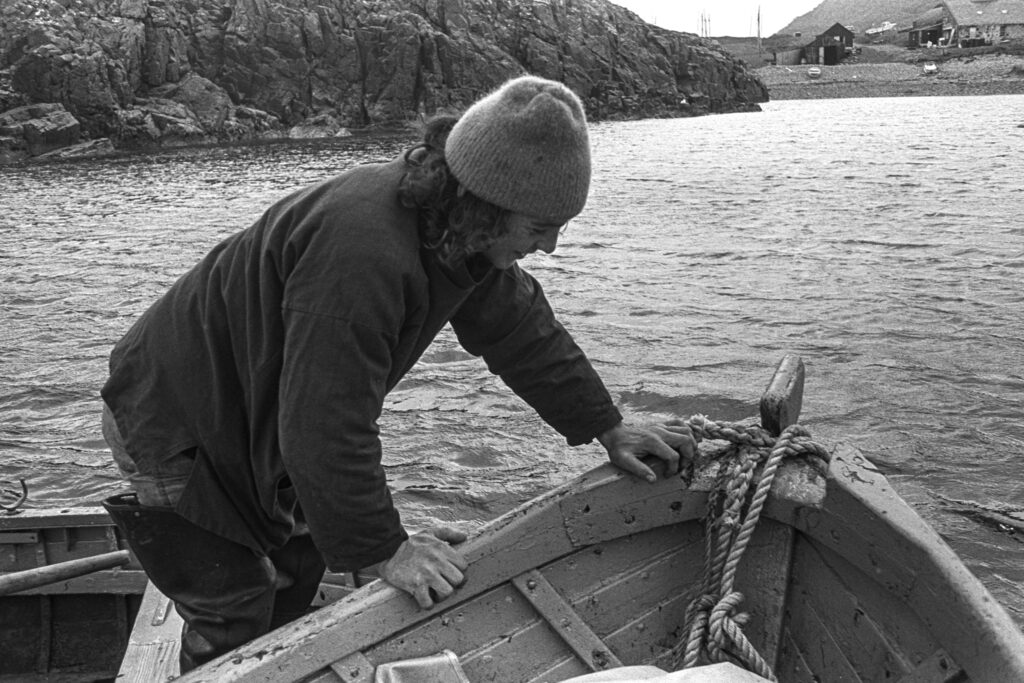
© Don McAllester
Photo 204
Tying the dinghy painter onto the coble mooring.
The coble mooring was in three parts: two pennants with split splices at the boat end to go over the stem head and attached at the bottom end to a rope that ran across the bay to chains attached to “pins” in the rock. The third part of the mooring was an anchor set to the north west.
Putting in the boat mooring was one of the first jobs of the season, taking it out one of the last.

© Don McAllester
Photo 205
Starting the engine
The coble had a 10HP Norwegian Sabb, a single cylinder, hand cranked, air cooled diesel. Starting it required a little squirt of oil into the rocker cover, using the decompression lever and then a good few turns with the crank handle. When it was really cold there was a strange little method of putting a combustible substance into its air intake. This usually got the motor going. It was a slow running noisy little engine.

© Don McAllester
Photo 206
Getting the bilge pump going
Any rain water that had collected overnight was pumped out in the morning. The pump needed to be primed to get it started.

© Don McAllester
Photo 207
Passing Ardtoe Island at Kilmory Point looking to see how the nets were lying. If the tide was rising, on the flood , the boat had to start fishing the net on one side. If the tide was falling, on the ebb, the boat would have to start fishing on the other side of the net. You could tell which way the tide was going by how the leader was lying: bowed to the south east and it was a flood tide, to the north west an ebb tide

© Don McAllester
Photo 208
Approaching the net at Kilmory Point
The headpole is standing vertically which shows the net is sitting well in the water. A good thing

© Don McAllester
Photo 209
The boat is now lying alongside the net. Paul is holding the net bridle; Rhoddy is just getting hold of the head pole
You can see this whole process in “Scottish Wild Salmon Company” footage in Videos

© Don McAllester
Photo 210
Rhoddy is now untying “springing” the headpole. Paul is holding the boat steady on the bridle. The headpole is one of the three poles that hold the net open and upright in the water

© Don McAllester
Photo 211
The headpole is now untied and falling out of the way. The crew are pulling the boat forward so that it is alongside the “fish court”: the chamber of the head net where hopefully there are fish

© Don McAllester
Photo 212
The boat is now as far forward as it needs to be. The headpole is lying out of the way. The crew are hauling on the “pull ropes” to bring up the floor part of the net

© Don McAllester
Photo 213
The boat has now been pulled across the net with the crew leaning over the side to hold the floor of the net to the surface thus forcing the fish into the bag created by the side wall of the net

© Don McAllester
Photo 214
The bag, with a fish in it, is being lifted up over the side and into the boat

© Don McAllester
Photo 214.1
The crew have now lifted the “bag” over the side and into the boat so that the fish can be emptied out of the net. The fish are very much alive.
There is good video of this in the CNN film on Videos

© Don McAllester
Photo 215
The crew are trying to get hold of a fish that has managed to get to the other side of the boat having been tipped out of the bag

© Don McAllester
Photo 216
Rhoddy has caught the fish and is dispatching it with what was called at Fascadale a “paddy” in other places a “priest” It was a ladder rung. Rhoddy was often heard to say “Morning Vicar” as he did this

© Don McAllester
Photo 217
The fish is finally dealt with

© Don McAllester
Photo 218
Not all the fish were swimming in the fish court when the net was fished. Here Rhoddy is trying to get at a fish caught by the gills, hung, in the wing of the net.

© Don McAllester
Photo 220
Working to get the “hanger” out. Paul is reaching back to pass Rhoddy a “paddy”

© Don McAllester
Photo 221
Paul now has the fish by the tail as Rhoddy deals with it, “paddy” in hand

© Don McAllester
Photo 222
Paul putting a freshly caught salmon into a fish box. Rhoddy is looking into the net, checking for damage and making sure there are no fish left in any corner. Salmon are very beautiful fish and the crew did their best to keep the fish in their best condition. Buckets of water were poured over dry decks before the catch were brought aboard to prevent the loss of any scales and thus some of their value. The fish in the photo has lost some of the scales around its “shoulders” probably by being caught in the mesh of the net. Most of the fish brought aboard were still swimming freely in the “fish court” head of the net when net was fished.

© Don McAllester
Photo 223
A box with four freshly caught
fish . The Glasgow fish market, where these fish were sold, differentiated between “salmon” and “grilse” According to the market a salmon was a salmon of more than 8lbs, a grilse a salmon of less than 8lbs. In scientific terms a grilse is a salmon that has only spent one winter at sea, a salmon a fish that has spent more than one winter at sea. The market paid more per pound for salmon than they did for grilse The big fish in the box is definitely a salmon, the other three look to be grilse. Unfortunately the big fish in the box, the salmon, has lost some of its scales by it shoulders. A fish like this would get slightly less at the market than a perfect fish.
The fish had quite a journey to the market. After being rinsed, weighed and boxed at Fascadale these fish were carefully packed: The boxes were lined with wet newspaper to provide insulation then the fish placed belly up, covered in crushed ice and the lids nailed down. Fresh salmon was a luxury food. The fish went to market whole, ungutted. The salmon farming industry was in its infancy in Britain: for most people fresh salmon was a difficult to get treat, and smoked salmon maybe only at Christmas. Changed days.
The fish boxes, each at just over a hundred weight (50+kgs) were taken by car and trailer to the Tobermory ferry at Mingary Pier, Kilchoan. In 1975 the ferry the “Lochnell” was a passenger only service. Using the manual crane on the pier the boxes were lifted onto the “Lochnell “which then set off for Tobermory. From there onto a lorry and down to Craignure on Mull for the ferry to Oban then from there by road to the Glasgow fish market A fish taken out of the sea on Tuesday morning would be at the market on Wednesday morning.
The value of the catch was very much driven by the economic law of supply and demand. At the start and end of the season, when very few fish were being landed the price per pound was high, in the middle of the season, during the “grilse run” when more fish were reaching the market, the price went down. These were the days before fish farming. Salmon was a luxury seasonal food and it commanded a high price. At the start of the season a salmon, a more than 8 lbs fish could get as much as £3.00 a pound. In high season a grilse might only be getting £1.40 a pound. Interestingly at the start and end of the season the catch was mainly salmon but not many of them, the main part of the season the catch was largely grilse.

© Don McAllester
Photo 224
The boat is alongside the net, bow out. Paul is holding the “head pole” in one hand and the net in the other.
This photo clearly shows the height of the side of the boat in relation to the height of the man. This boat had a very low “freeboard” (height of the side of the boat above the water) To an extent this was an advantage as much of the work on the nets required the crew to be leaning over the side of the boat to reach the net in the water. On the other hand the low freeboard offered little protection from the splashes and spray of the sea and little protection to somebody who might fall overboard
Lifejackets were not worn on the Fascadale boats: indeed the cobles carried no life saving nor any safety equipment. The protective clothing issued to the crew, a pair of thigh boots and a frock oilskin (see photo SSS link)would have made staying afloat in the water very difficult.
The fisherman in this photo is wearing thigh boots.

© Don McAllester
Photo 225
Jellyfish. These are the almost transparent type with the purple pattern on them. Harmless but heavy. The nets caught a lot more jellyfish than they did salmon. The quantity of jellyfish in the net was often a surprise and it was unknown what drove this variation: the tide, the wind, water temperature, a mystery. If the net was full of jellies the bag would be too heavy to be lifted into the boat to get at the fish. The jellies had to be got out by unlacing part of the side of the net then tipping the jellies out while making sure not to let a fish escape. Heavy tense work And then there were the red jellies, the stingers……
There is good video of the jellyfish problem in the “Scottish Wild Salmon Company” footage in Videos

© Don McAllester
Photo 226
Still trying to get the jellyfish out of the net
Paul “steering” and pushing jellyfish towards the fish door

© Don McAllester
Photo 227
Jellyfish
Rhoddy is now at work clearing the net of jellyfish
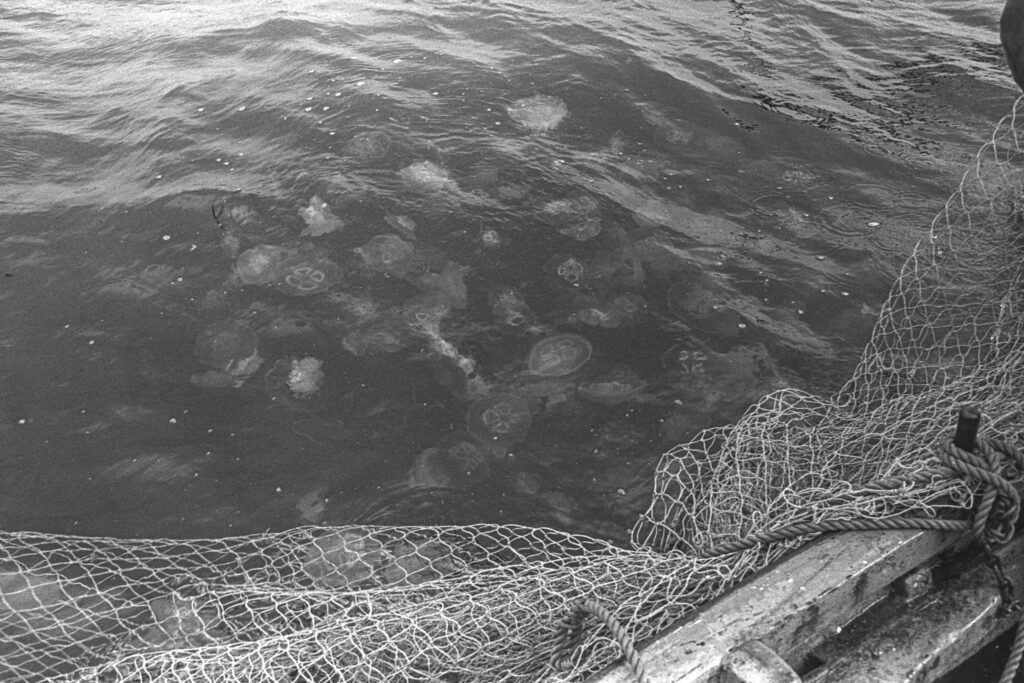
© Don McAllester
Photo 228
The jelly fish are now out of the net
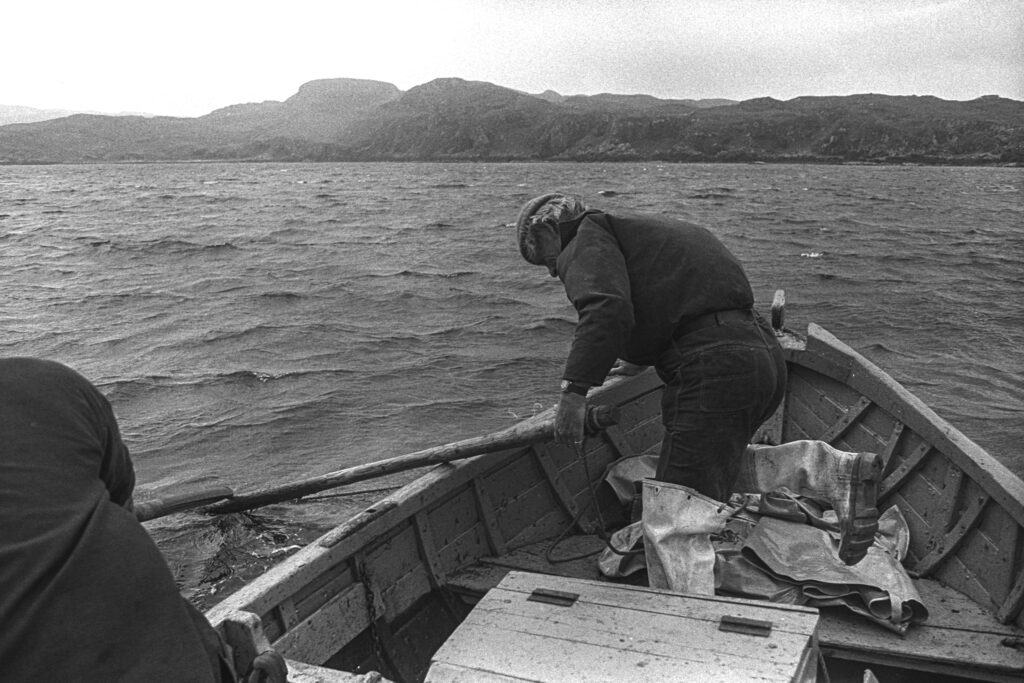
© Don McAllester
Photo 229
The crew are setting the net up to fish again. The headpole must be pulled back into position. Paul is pulling on the headpole with the boathook so that Rhoddy can catch the end of it
There is now quite strong breeze trying to push the boat away from the net
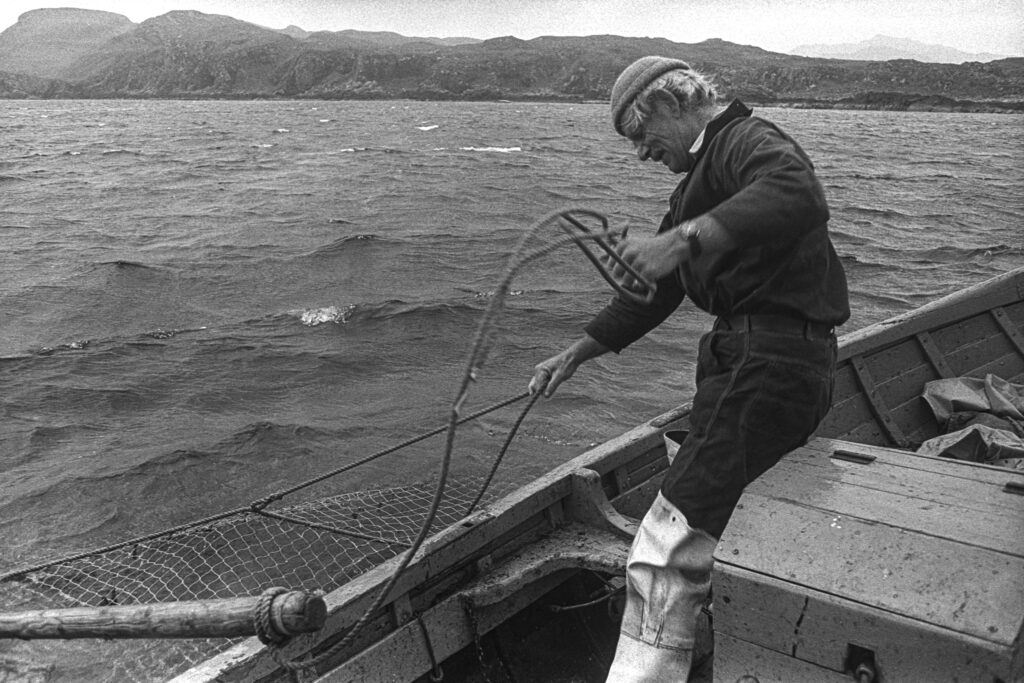
© Don McAllester
Photo 230
Rhoddy is holding onto a pull rope with his right hand to keep the boat in position whilst flicking the headpole rope to Paul with his left hand

© Don McAllester
Photo 231
Rhoddy is still holding onto the rope to keep the boat in position: Paul is holding the headpole and trying to pull the boat into position using the boathook
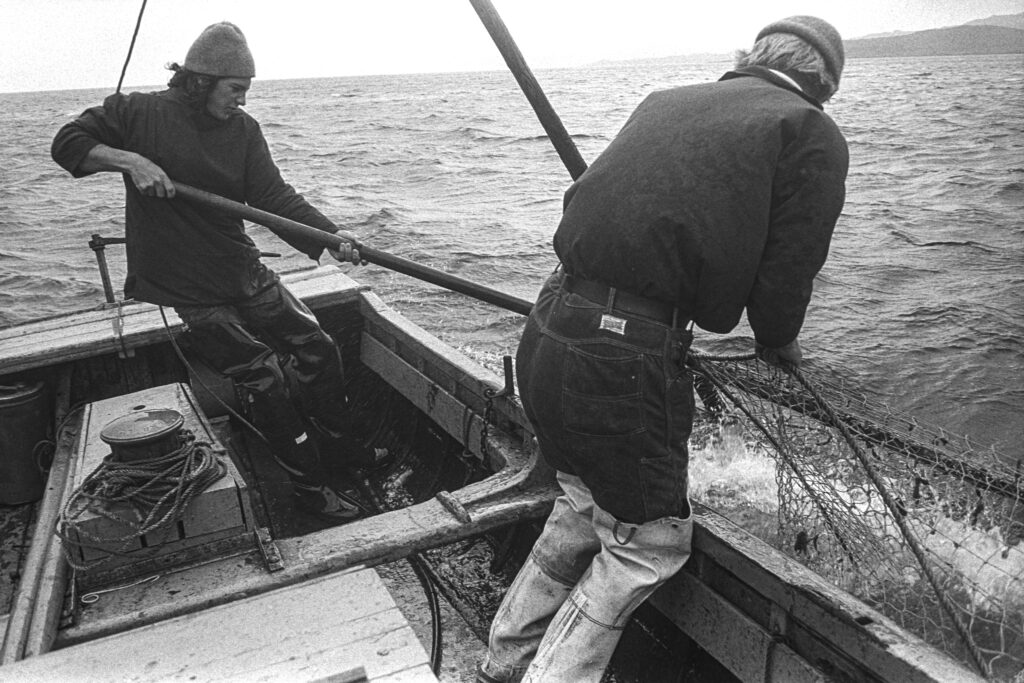
© Don McAllester
Photo 232
The headpole is now in the right place but the crew are working hard to keep the boat up to the net

© Don McAllester
Photo 233
Putting the “headpole” back in place
The boat is now almost secure so Rhoddy can start pushing down the headpole

© Don McAllester
Photo 234
On the way back to Fascadale with Ardtoe Island, Kilmory Point in the background

© Don McAllester
Photo 235
Returning to the bay at Fascadale in the “Wee” coble after fishing the nets. Through the season the coble was kept on a mooring in the bay unless there was a northerly or north westerly gale forecast in which case the boat was moved to “ Johnnie’s” a very sheltered spot along the rocky shore east of Fascadale The coble engine was being controlled by Rhoddy Macleod, the then owner of Fascadale. He is wearing the traditional knee length frock oilskin. The coble is approaching the dinghy ,which the crew use the dinghy to get themselves and the catch ashore.
The fishing season started in late spring but the still rough weather and the number of fish to be caught meant that activity ashore at Fascadale only really started in May with the nets going into the sea in early June. There was lots of preparatory work to be done: nets checked and repaired, boats serviced and painted, moorings to be laid and much more. The season officially closed on 26th August but by that time there were very few fish being caught so in most years all the gear would be out of the water by mid August. Once the gear was ashore there was still plenty to do, scrubbing weed growth off all the ropes and chains, cleaning, drying and properly storing it all and the tarring.
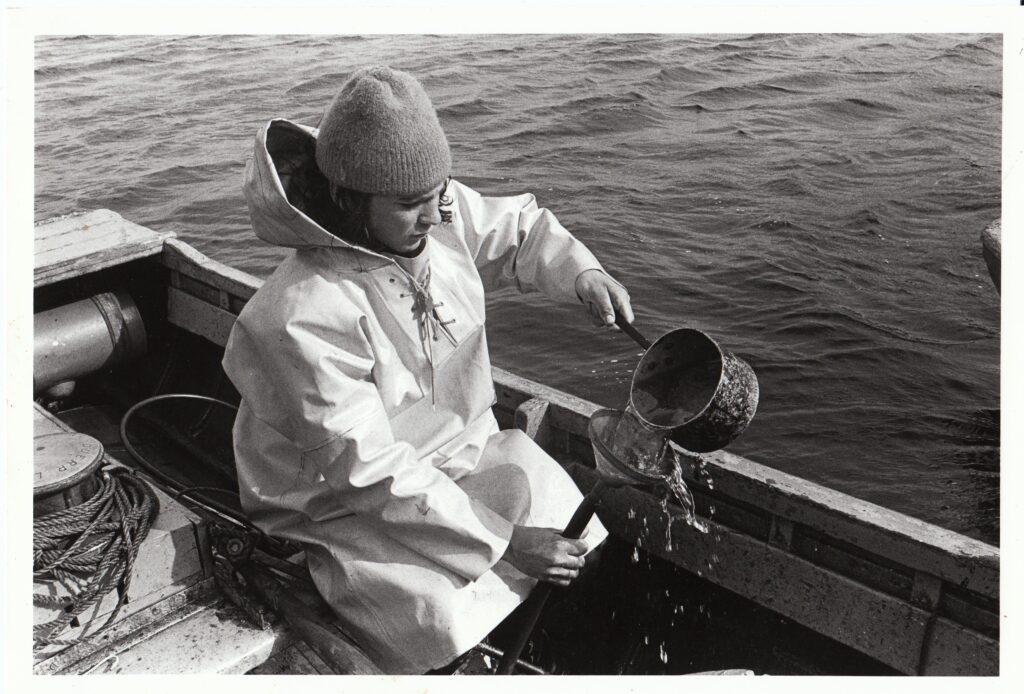
© Don McAllester
Photo 236
The mechanical bilge pump only ran when the engine was on. It was not the easiest pump to get started: it required water being poured into it to get the suction going and the device to work. To do this one had to find the funnel and the pan then start pouring water. This was maybe not the best set up to deal with an emergency. There was no manual bilge pump but the boat did have a couple of buckets
The fisherman is wearing a frock oilskin see photo III link
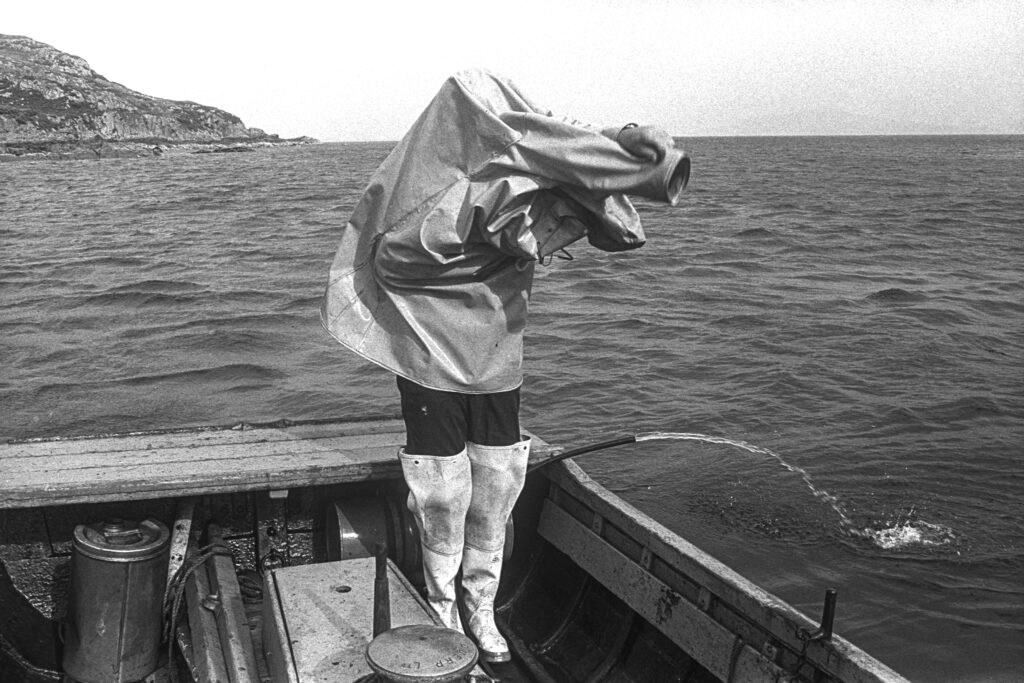
© Don McAllester
Photo 237
Rhoddy taking off his frock oilskin. These garments came down to the knee ( see photo JJJ link) and were made of a heavy synthetic cloth. They were completely waterproof. They had a hood but the cuffs were loose. The combination of frock oilskin and thigh boots worked well. There was nothing for a net to hook onto: you could stand in the water by the beach to load and unload the boat and at sea they kept the water out. However these were the days before “breathable” fabrics: working the nets was strenuous work so with no way for the perspiration to escape by the end of the day you could end up fairly damp.
The frock oilskin and thigh boot combination would have made it very difficult had you gone overboard.
The water flowing out of the hose to the right of the picture is coming from the boat’s mechanical bilge pump. Photo 333(link) shows this pump being primed. The engine had to be running for the pump to work. There was no manual bilge pump, just a couple of buckets.
This old wooden boat was quite “tight”, she did not leak much but she did have a low “freeboard” (height of the sides above the water) so she would take on spray. At the end of the day the boat was always washed down with buckets of sea water.
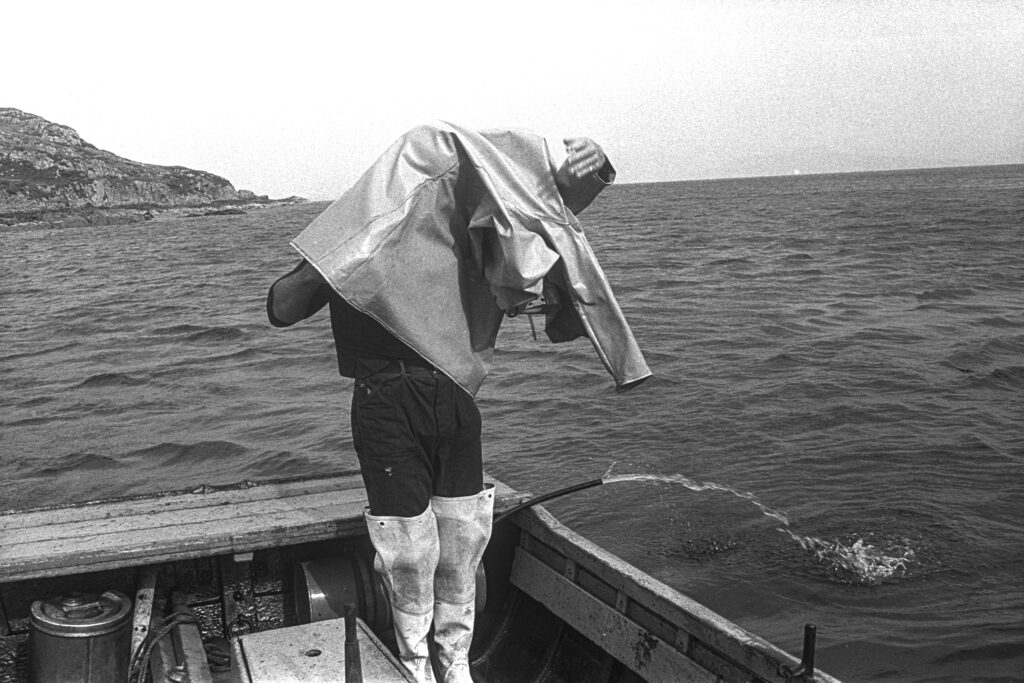
© Don McAllester
Photo 238
Almost there
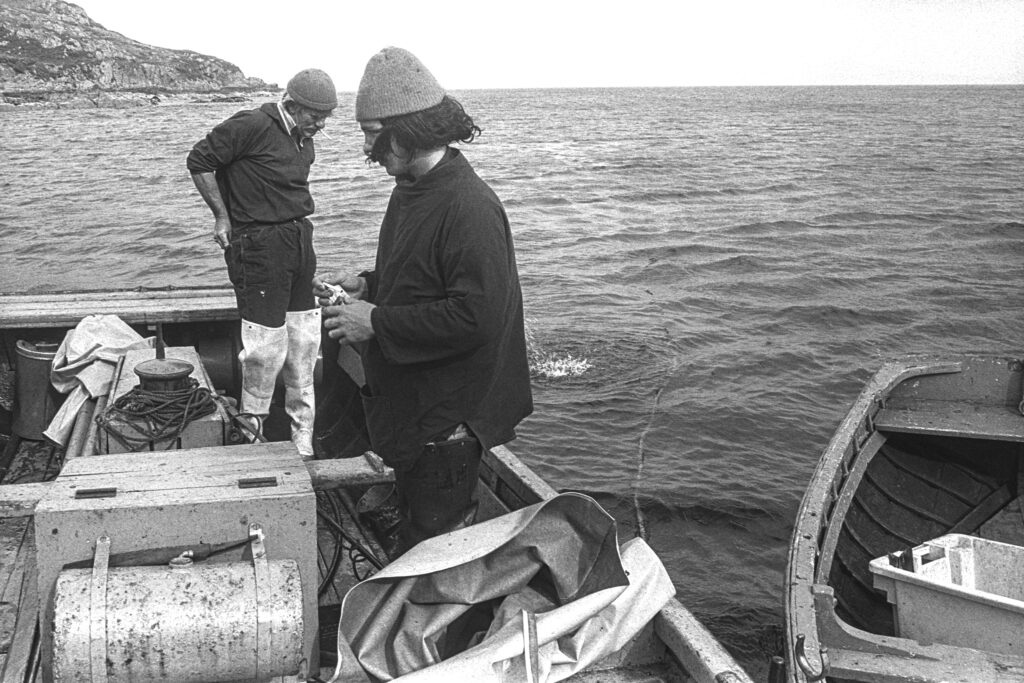
© Don McAllester
Photo 239
The oilskins are now off, the fish box is in the dinghy, the bilge pump is still working so the engine must still be running……time for a cigarette
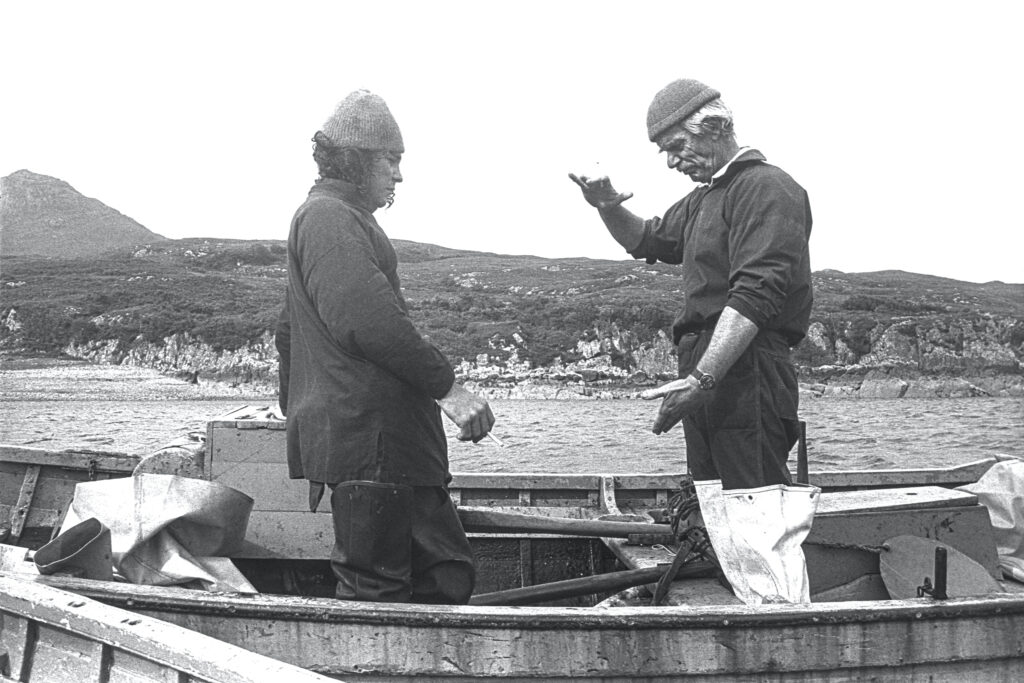
© Don McAllester
Photo 240
And you should have seen the one that got away……..

© Don McAllester
Photo 241
Rhoddy and Paul pulling the “grey” dinghy up the beach after returning from a fishing trip. The “wee” coble is in the background on her mooring. To get the boat right up the beach a long wire was attached to the front of the boat then a LandRover used to pull it up. Fascadale owned two very sturdy and very old clinker dinghies, the “grey” one and the “blue” one. These boats had to be painted on the outside then tarred on the inside each year. The tar helped keep them watertight. All very very traditional
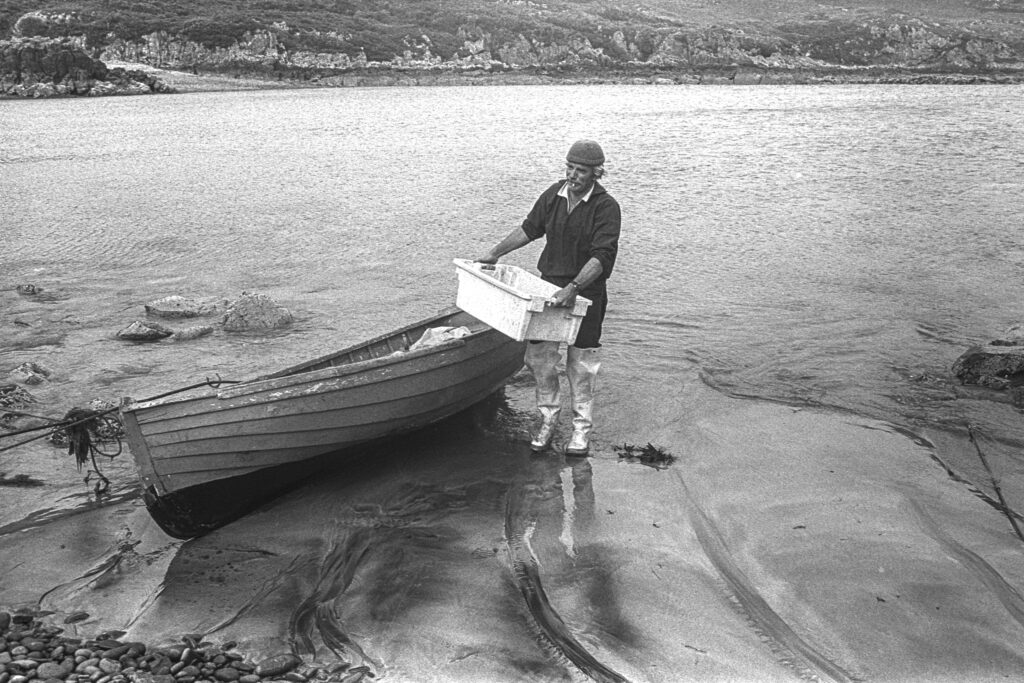
© Don McAllester
Photo 242
Rhoddy carries the morning catch up the beach. The plastic fish boxes used at Fascadale were all gifts from the sea: flotsam or jetsam washed up on the beach.
The dinghy has been left with a swell line hooked through its starboard rowlock and its long painter (bow rope) tied to the same swell line well up the beach. This meant the boat was kept in place through the rise and fall of the tide and could be pull in as the tide refloated it and in time for the afternoon fishing. The other swell line is just visible to the right of the photo
The boat in the photo is one of the two old clinker built dinghies, the “Grey dinghy” . Unfortunately being dragged down and towed up the stony beach was damaging to the boats. If you look carefully at this photo you can see the stem and keel timbers have come apart. Wood working skills at
Fascadale were very basic so no really good repair was carried out
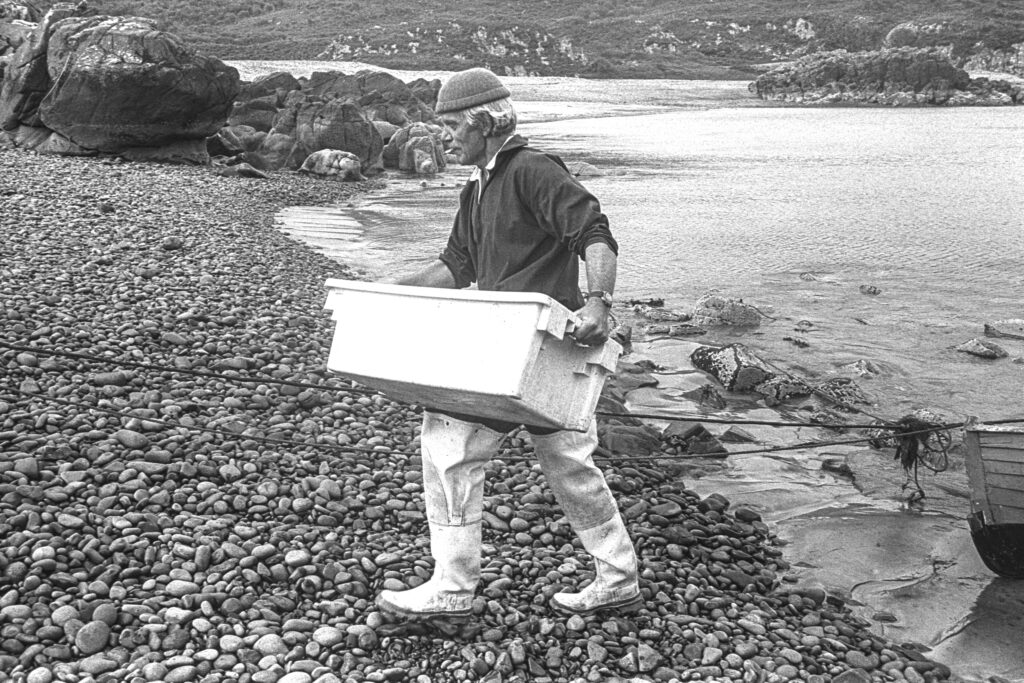
© Don McAllester
Photo 243
The beach at Fascadale changed shape every year with the winter storms. The “raised beach” the stony part would some years be an even gradient, other years it would be a series of steep ridges.
In this photo the dinghy is resting on the sand that would become visible at the bottom of the tide. The dinghy is held in place by her long painter (bow rope) and the swell line. (Link 333)
Also visible are the rocks that uncovered at low water. These were always as hazard if the coble had to be brought alongside the beach to unload (link 444)

© Don McAllester
Photo 244
The catch has been brought ashore in the white plastic fish boxes. Bobby Macleod, the wife of the proprietor managed the washing, weighing, packing and dispatch of the fish. From the plastic boxes the fish went into the zinc bath for a quick rinse then onto the wooden box scale visible hanging in the doorway. From there it was into a wooden fish box lined with wet newspaper for insulation, then covered with crushed ice and then the lid nailed down. The fish were not gutted but sent away whole and always packed in the boxes belly up
The shed behind the tin bath, the engine shed, housed the ice making machine. This petrol driven contraption using compressed refrigeration gas and a brine tank formed ice in the heavy metal cases visible behind Bobby Macleod . The big blocks of ice were put through a turnip grinder, a mangle, to be crushed. This laborious process was replaced a few years later when mains electricity finally reached Fascadale
The crew are going into the packing shed to change out of their sea going gear before helping with handling of the catch.
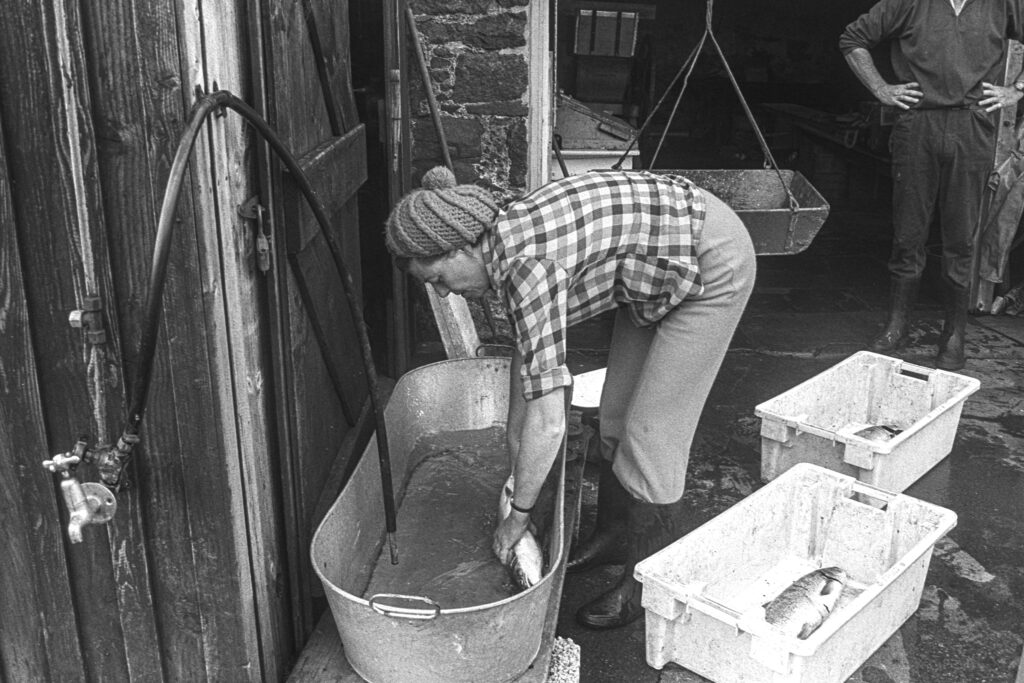
© Don McAllester
Photo 245
After the catch was brought ashore the fish were rinsed, weighed and packed
In this photo Mrs Macleod is rinsing the fish in the zinc bath beside the engine shed and outside the packing shed.
The wooden tray hanging in the background was used for weighing the catch. It was suspended from an old fashioned round brass scale.
When the weighing and packing of the fish was complete the tin bath was tipped out then it and the fish boxes were hosed clean
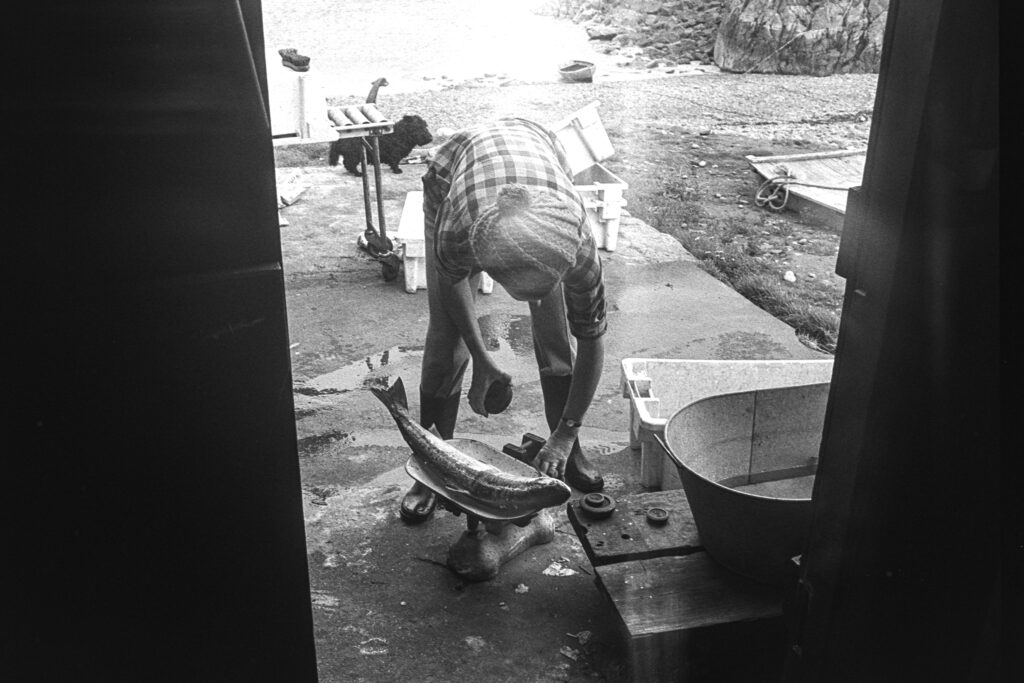
© Don McAllester
Photo 246
Salmon landed at Fascadale were sent to the Glasgow fish market to be sold. That market divided the fish into “Salmon” or “Grisle” A salmon was a fish of over 8lbs, a grilse a fish of under 8lbs. The market paid more per pound for salmon than it did for grilse
It was usually very easy to identify a salmon from a grilse visually. Fish that one was uncertain of were weighed individually. Mrs Macleod, Bobby, is weighing such a fish in the photo.
When the boxes were packed ready to go to market they were labelled with the number of salmon and grilse in each box with the number and total weight of each category
This picture was taken from just inside the engine shed and shows the tin bath for rinsing the fish, the dinghy on the swell line at the bottom of the beach, (Links) the black Scotty dog, “Gus” and to the right the front end of the wooden sledge used for dragging nets up the beach and then onto the net green.
The sledge would be manually pulled down the beach, loaded from the boat, then attached at the end of a long wire rope to be towed up the beach by LandRover. At the top of the beach the wire would be unhooked, then the vehicle turned, the sledge reattached directly to the vehicle then towed to the green for unloading. The crew had to walk beside the sledge to make sure none of the net slid off and under the sledge runners which would have badly damaged the net. Salmon fishing at Fascadale was labour intensive.

© Don McAllester
Photo 247
Paul outside the bothy at the end of the day
